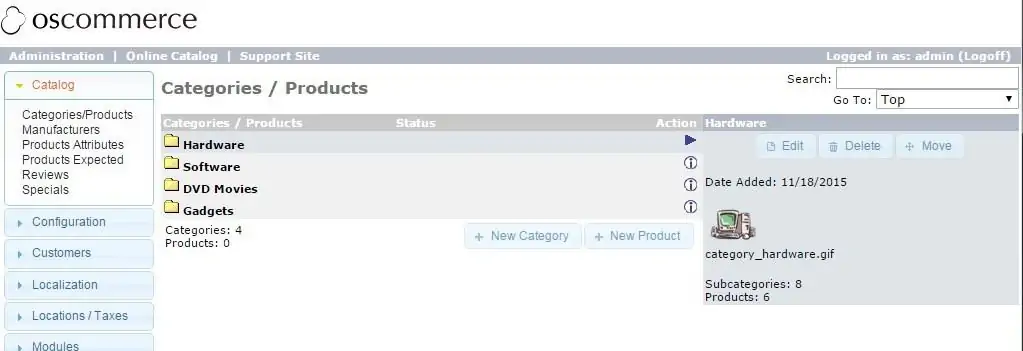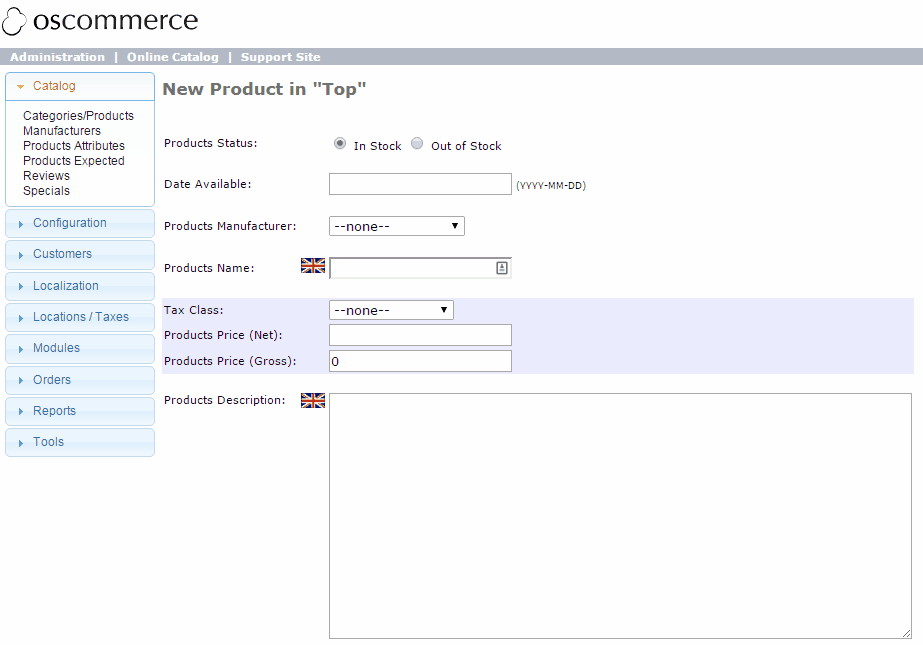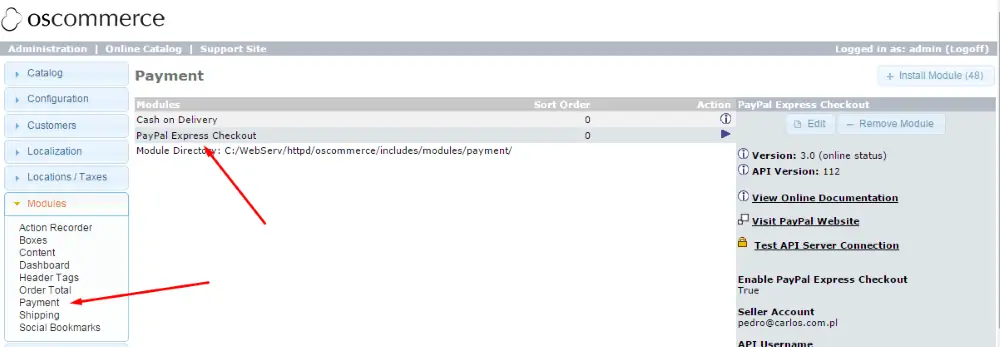
There are hundreds of thousands of members of the wider osCommerce community online, which includes developers, and a popular online forum for help and support. Truly open source and free to use under GNU General Public License, there are thought to be at total of over 260,000 different stores currently operating through the osCommerce platform.
There are hundreds of thousands of members of the wider osCommerce community online, which includes developers, and a popular online forum for help and support. Truly open source and free to use under GNU General Public License, there are thought to be at total of over 260,000 different stores currently operating through the osCommerce platform.

osCommerce review: in a nutshell
osCommerce is a self-hosted e-commerce platform. It can take care of both your front-end store catalog – your products – and your back-end management tasks (like adding products, managing sales, and etc.).
To use osCommerce, you need to first download it from the official website, and then upload it to your web server. The installation procedure is web-based and easy to get through.
osCommerce is open source. This means that you can modify it freely, without worrying that you’re violating some license agreement. Due to that, there’s also a lively community around osCommerce that’s always willing to help out with any issues you might have with the platform.
Who’s osCommerce best suited for?
osCommerce is a great option because it is easy to use, easy to tweak, and easy to get running just the way you want it. But there is a problem when it comes to reliability and scalability, and when your product database gets to a certain size, you will start to notice the website creaking a little, making it more likely to experience outages and technical difficulties.
For that reason, osCommerce is probably the right solution only for those who want to test the e-commerce waters, so to speak, before moving on to more feature-rich and functional solutions.
If you’re looking for something quick and easy to get started with, osCommerce might be the solution you need. But if you’re thinking huge scale, it might be more advisable to switch up to something more robust.
Features in osCommerce
osCommerce is a rather basic piece of e-commerce software, but it still delivers all the must-have e-commerce features:
- Product catalog management. You can have an unlimited number of products, product categories, manufacturers, product attributes.
- Special offers.
- Reviews.
- Customer management.
- Currency and language settings.
- Tax handling.
- Extension possibility through modules.
- Orders processing.
- Reports.
- Advanced tools (like banner control, cache control, database backups, security checks, and more).
osCommerce review: pricing
The main osCommerce software is completely free. You can just download it straight from the official website.
That being said, you will stumble upon additional costs:
- You need a hosting plan. Those usually start at around $5 / month if you’re on a budget (quality host will cost you more).
- You need to get a domain name for your store. Around $10 / year or so.
- Lastly, there’s the cost of good design/template, or any third-party modules that you want to have as part of your online store (to extend its out-the-box functionality).
The online store designs in osCommerce
Well, there’s no design in osCommerce, per se. You do get a very basic, standard store template when you install the platform, but it’s really nothing to brag about.

As you can see, it looks quite dated, and you probably won’t be using it for your store.
To get something better-looking, you can either:
- Check the Community Add-Ons section on osCommerce website, and look for themes there (free). Or:
- You can go to ThemeForest and get a premium template/design.
Managing products in your osCommerce store
While using osCommerce isn’t difficult, and can be grasped really quickly, the interface isn’t the most modern one. Working with the platform on a daily basis brings back the memories of software interfaces from the ’90s, and I’m not joking here.

Don’t get me wrong; all options are there, and browsing through the admin panel is intuitive, but the looks of it all are lacking, especially compared to some of the more modern e-commerce solutions.
Example screen when adding a product:

When it comes to payments, by default, osCommerce integrates with PayPal Standard, through a built-in module.

You can also get additional payment modules from the Community Add-Ons section on osCommerce website.
Review conclusion
Is osCommerce the right tool to launch your online store with?
Pros of osCommerce
- Large Community: There are hundreds of thousands of people involved in the wider osCommerce community, so there’s no shortage of casual support if you need it. The forum has over 1.5 million individual posts, so chances are high you will be able to answer anything that comes up reasonably quickly.
- Easy to Hack and Modify: If you want to hack, modify and manipulate the site for more control, osCommerce is particularly easy to break open, and you will find with a basic understanding of what’s going on, you can make modifications yourself. Alternatively, if you want to source a developer, you will be able to do so relatively easily to make the tweaks you need.
- Supports Additional Plugins and Add-ons: Due to the size of the community and the sheer number of websites running the osCommerce software, there are a wide range of plugins and add-ons available, which you can use to pack out the features of your site. Some of these are paid, but a large number are still available free of charge.
Cons of osCommerce
- Can Be Error Prone: osCommerce can be prone to bugs and breakdowns, particularly once you’ve gone as far as hacking the code yourself. This can be a problem if you’re doing a lot of volume – no one wants the shop to be broken when a customer gets to the checkout.
- Requires More Manual Intervention: As a result of the way some of osCommerce features are built, more manual intervention is required than with other software options. This means more of your time in managing and updating the site, to keep things relevant and well-targeted to your customers.
- Doesn’t Always Scale Well: Scalability is a much bigger concern with osCommerce than, say, Magento. Where Magento is built to scale, osCommerce is built for smaller-time applications. That isn’t to say osCommerce is any worse – just that it is not quite as neat to scale. If you do find yourself with an osCommerce shop that’s doing well, it may even be worth moving to a more powerful software to take things to that next level.

